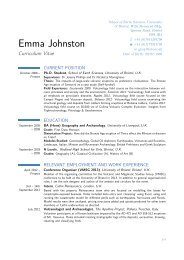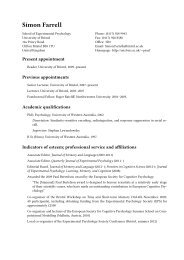What is Scientific Progress?
What is Scientific Progress?
What is Scientific Progress?
You also want an ePaper? Increase the reach of your titles
YUMPU automatically turns print PDFs into web optimized ePapers that Google loves.
However, the views do not in fact coincide since neither (i) nor (ii) <strong>is</strong> true. Furthermore, where the<br />
views differ, the cumulative knowledge account has the advantage.<br />
Considering (ii), it <strong>is</strong> clear that not all scientific knowledge <strong>is</strong> a matter of knowing the solution to<br />
some puzzle. Astronomers and natural<strong>is</strong>ts of the eighteenth and nineteenth century spent lives<br />
collecting data on stars and comets, or on new species and habitats. These were contributions, albeit<br />
not dramatic, to scientific progress. At the same time there are serendipitous d<strong>is</strong>coveries that<br />
progress science whose importance <strong>is</strong> clear without their being solutions to any puzzles.<br />
More significant <strong>is</strong> (i). Kuhn and Laudan do not think of solving a puzzle as involving knowledge,<br />
when knowledge <strong>is</strong> understood in the classical way as requiring truth. For Kuhn a puzzle <strong>is</strong> solved<br />
when a proposed solution <strong>is</strong> sufficiently similar to a relevant paradigmatic puzzle-solution.<br />
Laudan’s account <strong>is</strong> superficially similar to Hempel’s D-N model of explanation—a problem<br />
phenomenon P <strong>is</strong> solved by T when one can deduce P from T. But importantly Laudan does not<br />
require that T <strong>is</strong> true. He does not even require that P really ex<strong>is</strong>t: “A problem need not accurately<br />
describe a real state of affairs to be a problem: all that <strong>is</strong> required <strong>is</strong> that it be thought to be an actual<br />
states of affairs” (Laudan 1977, 16; Laudan’s emphas<strong>is</strong>). Nicole d’Oresme and h<strong>is</strong> contemporaries<br />
believed that hot goat’s blood would split diamonds (Oresme 1968; example cited in Laudan 1977,<br />
16). A theory from which the splitting of diamonds by hot goat’s blood <strong>is</strong> deducible would,<br />
according to Laudan, provide a solution to Oresme’s problem. It <strong>is</strong> clear that both Kuhn and Laudan<br />
countenance contributions to scientific progress that do not involve any knowledge. In Laudan’s<br />
case th<strong>is</strong> <strong>is</strong> because he thinks that we never have scientific knowledge—he accepts the pessim<strong>is</strong>tic<br />
induction as sound. In Kuhn’s case th<strong>is</strong> was initially because he wanted to give an account of<br />
scientific change that <strong>is</strong> neutral over questions of truth and knowledge. In the postscript to the<br />
7






